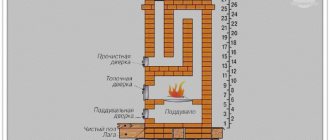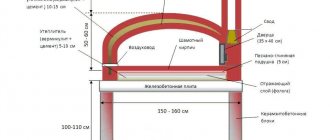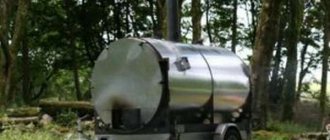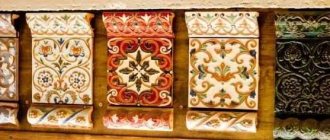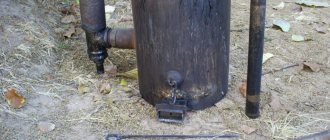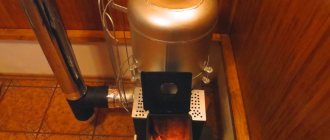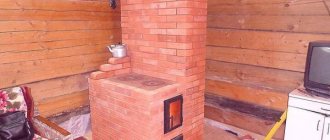Operating principle of a pyrolysis furnace
What is the operating principle of this stove? The processes occurring in it are unfamiliar to many, so it is necessary to study in more detail the principle of operation of a pyrolysis furnace.
A distinctive feature of a do-it-yourself pyrolysis furnace from a conventional one is that the fuel in it burns when there is a lack of oxygen. And this is surprising, because in conventional designs the fuel burns if there is a large amount of oxygen and this ensures the normal functioning of the entire heating system.
How does the pyrolysis process occur? When hydrocarbon fuels are burned, a process of oxidation and heat generation begins. Fuel under the influence of high temperature does not burn completely, releasing a large amount of various gases. The higher the temperature with a lack of oxygen, the more intense these gases begin to be released.
For example, if you burn wood fuel, gases such as acetic acid, acetone, and methyl alcohol will be released. Along with them, various resinous compounds and charcoal particles enter the chimney. These unburned residues can be re-burned because they are quite flammable. Gases that are not completely burned can be released when burning any fuel, such as natural organic matter or petroleum products. Different fuels have different combustion temperatures. Thus, petroleum products can burn at a temperature of 800-900 degrees, and firewood burns at 500 degrees.
Thus, the principle of operation of a do-it-yourself pyrolysis oven is to burn these gases. That is why such furnaces are also called gas generators. Pyrolysis is the process of decomposing fuel into its component parts when heated, followed by their combustion and release of heat.
Brick kilns and pyrolysis
Brick kilns are still in demand, although their peak of popularity has long since passed into oblivion.
Experts say that a long-burning brick stove is perfect for fully heating a private home. The design drawing is simple, and therefore you can organize it yourself. The power of heating equipment reaches 50 kW and above. There are furnace diagrams with a water circuit. Also read: “Which stove to choose for heating a house: brick or rocket?”
The operating principle of a brick kiln is based on the resistance of burning fuel and lining. At the very beginning of the pyrolysis reaction, light volatile gases burn. Their heat is absorbed by the lining through the chimney. Thus, the temperature in the firebox and stove rises to a fairly high level. This allows the heavier, volatile components to crack and carbonate the wood. The heated lining acts as a kind of thermal buffer. When there is a lack of heat, it releases it, and when there is excess, it takes it away.
New fuel is added gradually to a pyrolysis-type brick oven. You cannot use energy carriers with high heat capacity. Otherwise, the firebox will “suffocate”, which will negatively affect the efficiency of the equipment. It will drop to 70%. Options with an accident are also possible if the lining cannot cope with strong temperature fluctuations.
Advantages and disadvantages of a pyrolysis furnace
This design has certain advantages over conventional ovens. These include:
- efficiency reaches 80%;
- fuel is consumed very economically;
- the ability to regulate the long-term combustion process;
- environmental friendliness. During operation, such a stove produces virtually no emissions of carcinogenic substances.
If a pyrolysis oven is made correctly, then its advantages are countless. For example, it has virtually no soot , which makes it easier to maintain cleanliness and spend a small amount of time cleaning the stove. And there are a lot of such small advantages.
However, the pyrolysis oven also has disadvantages:
- high price. It is more profitable to do it yourself;
- big sizes. If the room is not too large, it is better to use other heating structures;
- Such stoves are heated only with a certain type of fuel. Dry fuel (wood) is best suited because high humidity has a negative effect on the pyrolysis process;
- For its operation, a power supply is required, and a constant one at that. For best operation of the oven, it should be connected to an electrical network.
These are the main disadvantages of a pyrolysis oven. So you can safely operate such a stove if there is enough space for it, dry fuel is available and there is access to the electrical network.
Which oven should you choose?
Today you can find drawings and diagrams of long-burning furnaces of a wide variety of designs, sizes and performance. However, how effective will the chosen homemade equipment be, and where can it be used? Experts answer this question as follows: a homemade pyrolysis oven made from scrap materials is perfect for non-residential premises. However, it will be low-power and short-lived.
For residential spaces, performance is as important as aesthetics. In this case, you need to pay attention to the potbelly stove in a modern modification. Its modified air duct and water jacket will allow you to heat a room up to 25 square meters in area. To increase productivity and heat a larger house, the size of a long-burning stove cannot be increased. To solve this problem, they opt for brick pyrolysis units. Thematic video on how to make a potbelly stove with your own hands:
A pyrolysis oven definitely requires learning a lot of information if you have the idea of creating a pyrolysis oven with your own hands. And the first number on the list of knowledge will be an understanding of the pyrolysis process. The use of solid fuel gas-generating boilers in private households has become popular. However, buyers are offered only calculations of the efficiency and advantages of the installations. You should know that thermal decomposition of wood occurs in almost all cases of its combustion.
Pyrolysis boiler manufacturing technology
To make a powerful boiler, you need to be able to handle an angle grinder and a welding machine, as well as understand the drawings. If you independently manufacture a boiler with a power above 25 kW, you must do everything according to the drawing , otherwise the boiler will not meet safety requirements.
The walls of the boiler should be made of heat-resistant steel, only this will guarantee that it will last for quite a long time. If such steel cannot be found, you can use ordinary steel, only in this case the internal chambers of the boiler are lined with fireclay bricks.
Boiler manufacturing stages.
- The boiler body is made of sheet steel. Using a grinder, boiler parts are cut out of a sheet of metal, holes are made in the walls for the ash pan door and loading door, as well as for pipes and a smoke exhauster. The most important thing is to adhere to the dimensions indicated in the drawing. Using a welding machine, the parts are connected, after which the seams are cleaned of scale and ground.
- Then the pipes are welded so that there are no gaps between the seams. A pipe of the required diameter is taken and a protective heat exchanger is installed on the rear wall of the boiler. After that, they check whether the heat exchanger is leaking due to increased pressure from the compressor, and only then install the rear wall of the chamber, made of heat-resistant steel.
- Then they begin to install a partition that separates the gasification and gas combustion chambers, installing a cast iron grate. An air duct with a damper is made at the top of the gasification chamber. An air duct is also made at the bottom of the chamber and at the same time the bottom and sides are lined with fireclay bricks.
- The boiler doors are made of heat-resistant steel, and for maximum tightness they are reinforced with metal corners.
- The boiler should be installed in a non-residential area, connecting the chimney. Then a water circuit is connected to it and a smoke pump is installed.
Manufacturing technology of a pyrolysis furnace
This boiler is very powerful and therefore suitable for a large house. To keep your garage or country house warm, you can build a pyrolysis oven with your own hands. It is also made from a sheet of metal, but its manufacturing technique is much simpler.
If the gas combustion chamber is located above the gasification chamber, creating natural draft, then there is no need to use a smoke exhauster.
The stove is not connected to the heating system.
Such a furnace is not automated and therefore requires constant monitoring and adjustment of the combustion mode.
How to make a pyrolysis oven with your own hands?
The technology for making a pyrolysis furnace with your own hands is carried out in the following sequence.
- Take the furnace body, which has holes for the firebox door and ash pan door, and weld it. It must be made of heat-resistant steel. A combustion chamber is installed directly and separated from it by a cast-iron grate. The flow of air into the firebox is regulated using the ash pan door.
- A gas combustion chamber is placed above the firebox, separating them with a heat-resistant steel plate. A channel is made in the chamber to provide air supply.
- The metal doors of the firebox and ash pan are reinforced with a corner.
- Inside, both chambers are lined with fireclay bricks, which will protect them from rapid burning and improve heat distribution. If the stove is installed in a living room, then it can also be covered on the outside so that you do not accidentally get burned on it.
- A damper is installed in the chimney to regulate draft. The chimney is made of an insulated pipe, which increases its safety. If the pipe is not insulated, in the event of sudden temperature changes, condensation accumulates on its inner surface, which can destroy the metal.
Materials for work
To build a long-burning brick pyrolysis furnace with our own hands, we will need the following materials:
- refractory ceramic bricks - 400 pcs; fireclay bricks - 100 pcs; sheet steel 6x1.5 m, thickness not less than 4 mm - 9 m2 cast iron grate of standard size - 3 pcs; concrete B12.5 - 0.12 m3 fan, power minimum - 300 W ;temperature regulator; door for the ash pit; door for the firebox; metal pipes; metal profile; ready-made high-temperature mixture for masonry - 470 kg; electrodes; high-temperature sensor.
Installation location of the pyrolysis furnace
Install the pyrolysis oven indoors, observing safety precautions to prevent fire. Do not install it near flammable objects, under shelves, or in easily blown places. There should be free space around the stove on all sides with a distance of half a meter. It’s good if there is a container with sand or a fire extinguisher hanging nearby.
In order for a do-it-yourself pyrolysis furnace to work for a long time, it is necessary to remove coke and carbon deposits from the lower part in a timely manner . If fuel oil or petroleum oils are used as fuel, care must be taken to ensure that no water gets into it. If this happens, the oven will start to “shoot”, throwing out a large number of sparks, and this can lead to a fire.
Therefore, subject to safety precautions and proper operation, such a stove can last a very long time.
Assembly
It is necessary to assemble the structure with your own hands according to the drawings and at the site of operation. After laying the foundation, the internal walls and ash compartment are installed. Structural elements are assembled using welding.
Pyrolysis oven in nature
The heat exchanger, chambers, and grates are being assembled. External stiffeners and walls and a top plate are installed. Water tanks are being installed. Sand is poured between the walls (it is pre-calcined to get rid of organic components), which will accumulate heat and prevent overheating of the structure.
Primitive design of a pyrolysis furnace
The chamber doors are installed. Connection is made to the circuits of the water container. The metal structure, made by hand, is ready for use.
Scheme of a pyrolysis furnace

